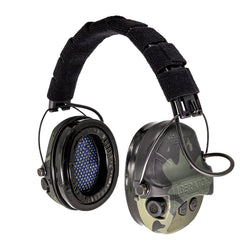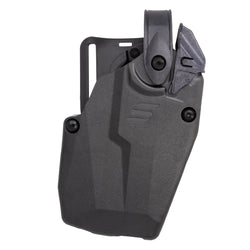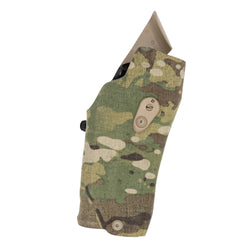The 10mm Auto cartridge is one of the most versatile cartridges on the market. It’s long been championed as a bear cartridge, a defensive round, and a gunfighter’s cartridge. My question is, does the 10mm’s extra oomph offer any real advantages to defensive shooters?

The best place to start is the beginning, so let’s start with the incident that made the 10mm popular, and what might answer my question.
It’s a muggy April day in Miami, 1986. FBI agents are on the hunt for two well-armed bank robbers. What follows will change the world and spark the rise—and fall—of the 10mm Auto.
The Explosive Origin of the 10mm Auto
Michael Lee Platt and William Russell Matix were violent, brutal men who had made a habit of robbing armored cars and banks. They weren’t afraid to flip the switch. The FBI was working a rolling stakeout searching for a vehicle they believed the men were using.
At 0930 AM, two agents spotted the vehicle and began tailing it. Five unmarked cars with eight agents joined the pursuit. After running the car off the road, a vicious firefight ensued. It was eight agents against two suspects, but the FBI found themselves on their heels.
At the end of the fight, two FBI agents were killed, five were wounded, and both suspects were dead. The FBI agents were armed with handguns, except for one 870 shotgun. The perpetrators were armed with handguns, a shotgun, and a Mini-14.

Both suspects absorbed multiple rounds—Matix was shot six times, and Platt twelve. The gunfight created an uproar that prompted the FBI to reexamine their small arms, their training, and even the caliber they fielded. At the time, agents were shooting .38 Special and 9mm, and the FBI decided that wasn’t enough.
In 1983, the 10mm Auto was created by Norma with the advice of Jeff Cooper. The new cartridge propelled a 200-grain bullet at 1,200 feet per second, outperforming .45 ACP, .38 Special, 9mm, and even .357 Magnum. As its name implies, the 10mm Auto was designed specifically for semi-automatic handguns.
The FBI Wounding Ballistic Lab tested both 9mm and .45 ACP and found each capable, with some dispute over which was better. The 10mm was seen as a perfect in-between. Subsequently, the FBI adopted the 10mm round and an S&W handgun.

The FBI and the 10mm Auto
The FBI’s adoption of the 10mm cartridge sent ripples throughout the firearms industry. It was a big deal for the bureau to adopt this somewhat unknown caliber. However, the FBI did not go with the full-power load that would later make the 10mm famous.
Instead, they developed a reduced-power version, launching a 180-grain projectile at about 950 feet per second. This “downloaded” round provided adequate penetration, matching the ballistics of the .45 ACP while allowing for greater magazine capacity. It had far less recoil and muzzle blast compared to a full-power 10mm load.

This led to the creation of the FBI Load, or “FBI Lite,” 10mm Auto. The FBI initially experienced issues with their 10mm Smith & Wesson pistols. While S&W resolved those problems, they also realized that the full-length 10mm case wasn’t necessary for the lighter load.
This insight led to the development of the shorter .40 S&W, which eventually became the standard law enforcement caliber until roughly 2015.
Is 10mm Too Much?
I tell this long FBI story to provide context on the history of the 10mm and circle back around to the original question: Is the 10mm too much for self-defense?
It seems like the FBI certainly thought so. The 10mm’s adoption was due to a bit of an argument over whether the 9mm was better than the .45 ACP. Both cartridges were deemed viable for duty use, but consensus was never reached.

A midway caliber like the 10mm seemed to please everyone, kind of. Our core question is, “Is the 10mm too much for self-defense?”
The FBI seemed to think so. They significantly reduced the velocity with their lighter loads, aiming for a cartridge that could reliably penetrate 12 inches of ballistic gel without exceeding 18 inches. The 9mm, .45 ACP, and 10mm all met these penetration goals. The FBI 10mm Lite easily achieved the standard, leaving no need for a full-powered 10mm load.
How Handguns Wound
Would a full-powered 10mm load stop a threat quicker than the FBI Lite? Evidence and science say no.
Handgun cartridges aren’t moving fast enough to create secondary wounding effects. Their damage comes from direct contact with the target. Compared to long guns, handgun rounds suck at fighting and stopping threats.
A handgun projectile has to hit something vital to end the fight, and this requires adequate penetration.
If the FBI 10mm Lite load, which is basically a .40 S&W, can reach and exceed those penetration standards, what would extra velocity do to stop the threat? If it’s a traditional two-legged bad guy, it doesn’t do anything. The only value would be deeper penetration, but with modern jacketed hollow points, even that’s up for debate.

With that said, are there any downsides to that extra velocity? Over-penetration could be a concern, but if the company has designed an adequate hollow point, that’s not an issue. The real downside comes from what happens on the opposite end of the barrel.
There is no free lunch. Extra velocity means extra recoil and muzzle rise, making the gun harder to handle and harder to shoot fast and straight. You’re getting extra velocity that rarely provides a real benefit, but you’re sacrificing ease of handling in return.
Where 10mm Shines
The 10mm might be too much for self-defense against the typical criminal, but that doesn’t make it useless. In fact, it’s an excellent outdoor cartridge. It’s long been a popular choice for outdoor defense.
If you’re camping, hunting, or hiking and need a powerful handgun to deal with predators or other dangerous animals, the 10mm is the perfect choice. Get a full-powered 10mm round with a deep penetrating projectile, and you can drop something as big as a bear.

With modern 10mm Auto handguns, you can carry anywhere from nine to 15 rounds. That’s more than many powerful magnum revolvers, and the semi-auto design generally produces less recoil than a standard magnum revolver. You get more rounds and can shoot faster.
Tuck a Glock 20 into a Safariland chest rig and you can defend yourself from most threats in the great outdoors—whether that’s ne’er-do-wells, bears, hogs, or more. The 10mm’s versatility makes it perfectly suited for outdoor use.
Ditch Your Centimeter?
If you carry a 10mm and like it, then no one is saying you have to ditch it. I used to be a 10mm purist and only wanted to carry full-power rounds. That was before I had a more nuanced view of how handguns stop threats.
If I were to carry a 10mm Auto today, I’d probably carry a fairly light load to avoid unnecessary recoil. The beauty of the 10mm, however, is the option to swap in hard-cast 200-grain rounds at 1,200 feet per second when facing serious outdoor threats like bears.

The old 10mm Auto remains popular with a cult-like following, and there is something to be said for the old cartridge and its ability to stick around.









